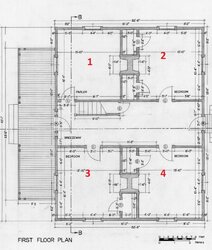Hi All,
Trying to absorb the wealth of information here on the forum. Still tough to find an exact answer/opinion for some issues.... so here my question.
I've been a baseboard natural gas customer for my whole life, so I'm trying to come up to speed on oil/wood/pellet since I'm looking at some oil heated houses in places where there is no nat gas available (i.e. southern New Hampshire). I pay anywhere from $1500-2000 per season with the heat cranked to 70 on two or 3 floors in a circa 1890 3 family. I'd guess the area i'm heating is ~1500 sq ft)
Assumptions for potential house...
2 story older farmhouse (early 1800s to 1900s) (3 if you include with finished/unoccupied attic).
Roughly 1600 sq ft/floor, going by outside house dimensions. Four 15x15 rooms + large/long breezeway + staircase..
new-ish Forced hot air system
Fireplace in each room.
If I have a floor layout similar to the attached picture on the first floor... with rooms marked "1", "2", "3", "4".
How readily would heat get from say room "1" (living room w/pellet) to room "4" at the opposite corner?
Would a large pellet stove be able to bring that opposite corner room "4" up to a decent temp in a reasonable amount of time with/without fans?
I understand that heated air will need to make a mad dash through the area with the breezeway and staircase... where undoubtedly some of it will get whisked away to the upper floor.
I'm assuming that at some point oil is going to go back up, and it would seem that trying to locate the heat where the people are would be the best bet to save money in the long run. so Maybe it would be better to consider a pellet for the second floor and crank that up an hour before bedtime to keep the second floor warm.
No clue how many gallons oil a oil forced hot air system is going to use trying to keep an old house up over 65.
Trying to absorb the wealth of information here on the forum. Still tough to find an exact answer/opinion for some issues.... so here my question.
I've been a baseboard natural gas customer for my whole life, so I'm trying to come up to speed on oil/wood/pellet since I'm looking at some oil heated houses in places where there is no nat gas available (i.e. southern New Hampshire). I pay anywhere from $1500-2000 per season with the heat cranked to 70 on two or 3 floors in a circa 1890 3 family. I'd guess the area i'm heating is ~1500 sq ft)
Assumptions for potential house...
2 story older farmhouse (early 1800s to 1900s) (3 if you include with finished/unoccupied attic).
Roughly 1600 sq ft/floor, going by outside house dimensions. Four 15x15 rooms + large/long breezeway + staircase..
new-ish Forced hot air system
Fireplace in each room.
If I have a floor layout similar to the attached picture on the first floor... with rooms marked "1", "2", "3", "4".
How readily would heat get from say room "1" (living room w/pellet) to room "4" at the opposite corner?
Would a large pellet stove be able to bring that opposite corner room "4" up to a decent temp in a reasonable amount of time with/without fans?
I understand that heated air will need to make a mad dash through the area with the breezeway and staircase... where undoubtedly some of it will get whisked away to the upper floor.
I'm assuming that at some point oil is going to go back up, and it would seem that trying to locate the heat where the people are would be the best bet to save money in the long run. so Maybe it would be better to consider a pellet for the second floor and crank that up an hour before bedtime to keep the second floor warm.
No clue how many gallons oil a oil forced hot air system is going to use trying to keep an old house up over 65.


